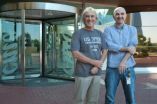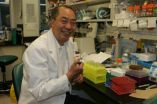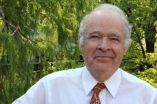(Press-News.org) VIDEO:
One third of cancer patients are killed by a 'fat-burning' process known as cachexia.
Click here for more information.
Most cancer researchers are working on the biology of the tumour. However, Michele Petruzzelli, a member of Erwin Wagner's group at the Spanish National Cancer Research Centre (CNIO), has been looking for ways to attack the disease indirectly. He focused on the effects of tumours on the rest of the body, and not on the tumour itself. His work on the body's response to a tumour has uncovered that cachexia—the extreme thinness and weakness eventually being the real cause of death in one third of patients with cancer—is triggered by a process that is heavily studied not to fight cancer, but to fight obesity: the conversion of white fat tissue into brown fat tissue.
"It is the first time that this phenomenon we might call burning fat has been associated with a negative effect", says Erwin Wagner, the Director of the BBVA Foundation-CNIO Cancer Cell Biology Programme. "What we observe is that the transformation of white fat into brown fat, currently one of the most researched subjects because of its potential effects on obesity and diabetes, has very severe consequences in the context of cancer". The study is published in Cell Metabolism.
The researchers also argue that if it is possible to reduce the transformation of fat tissue, the symptoms of cachexia will improve, although they do not completely disappear. The authors demonstrate this by blocking mediators of inflammation, a process linked to cachexia, specifically, to the expression of the pro-inflammatory cytokine IL-6.
"Inhibiting the conversion of white fat into brown fat is therefore a promising way of improving cachexia for cancer patients", the authors state in their article.
The CNIO has a large variety of animal (mouse) models for different types of cancer. The starting point for this study, says Petruzzelli, was to choose a dozen of these mouse models to investigate the changes that develop in their bodies as the tumour progresses. The researchers observed several changes in different organ systems, which varied depending on the animal model used as well as the tumour type. Nevertheless, a consistent white fat to brown fat transformation was observed in all organ systems very early, before any sign of cachexia became apparent.
'Good' Fat and 'Bad' Fat
There is a growing interest in this study because of its significance in two ways. It relates to the transformation of white fat into brown fat, which is beneficial to fight obesity and diabetes, but has a huge disadvantage in cancer-associated cachexia (CAC), which for different reasons has not been studied very much in the past. In recent years both approaches have become hot topics for researchers around the world.
The importance of the transformation process of white fat into brown fat in humans was only discovered a couple of years ago. Most fat in adult humans is white—white adipose tissue—and we know that its main function, but not its only function, is to store energy (those love handles). Brown fat, however, is burned to produce heat; baby fat and the fat of hibernating animals is like that. In the context of the current obesity epidemic, white fat has been labelled bad fat, while brown fat is the good one.
The discovery that adult humans can turn white/bad fat into brown/good fat via exercise or exposure to low temperatures has opened a new line of attack on obesity, and in fact the active search for pharmacological tools to induce the transformation of fat is well underway.
The work of Wagner's group in the article in Cell Metabolism does not discuss the advantages or disadvantages of each type of fat, it rather highlights that a process that could be strengthened to fight obesity must be fought against in cancer patients.
As for cachexia, it is a less-studied phenomenon despite that doctors have known for a long time that the treatment is difficult and the prognosis negative. Next to patients with cancer, it also affects patients in advanced phases of many illnesses, including infectious diseases, such as AIDS or tuberculosis, and chronic illnesses, such as multiple sclerosis.
It Is Not 'Self-Cannibalism'
CAC has until recently been interpreted as a kind of self-cannibalism: the body 'consumes' itself while trying to supply the energy needs of the constantly growing tumour. Today we know that tumours of any size can cause cachexia, including very small ones, and even at very early stages of tumour development, which does not fit with the idea of self-cannibalism. Researchers have observed that the process does not respond either to the body's greater need to generate heat.
These new data, and the often ignored fact that it is the cachexia associated with the tumour—and not the tumour itself—that causes the death of one third of cancer patients, has encouraged the study of this syndrome in recent years. It is now known that this process is tightly associated with inflammation, a hallmark of many cancer types.
This is why in their study Wagner and his group explore the link between inflammation, cachexia and the process of transforming white fat tissue into brown fat tissue. Their results indicate that if the activity of one of the agents that promotes inflammation—cytokine IL-6—is blocked, the fat transformation process is substantially reduced and, as a consequence, the cachexia. The researchers do point out that it is not a cure: IL-6 is just one of several cytokines involved in the process and blocking it is not enough.
A Way To Prevent Cachexia
These novel results suggest that anti-inflammatory drugs could help fight cachexia, but there is a problem: the lack of knowledge about this syndrome is such that for now it is not possible to predict which cancer patient will develop cachexia. Furthermore, anti-inflammatory drugs have often side effects, and therefore these treatments cannot be used to prevent the appearance of cachexia in all cancer patients.
The current study in Cell Metabolism could open up a new way of discovering processes, eg the transformation of fat in the initial stages of cachexia. "It allows one to think of the possibility to identify biomarkers that would help to predict which patients are going to develop cachexia in a way we can treat them preventively", says Petruzzelli.
INFORMATION:
The study was financed by the BBVA Foundation, the Ministry of Economy and Competitiveness and the European Union.
Reference Article
A Switch from White to Brown Fat Increases Energy Expenditure in Cancer-Associated Cachexia. Michele Petruzzelli, Martina Schweiger, Renate Schreiber, Ramon Campos-Olivas, Maria Tsoli, John Allen, Michael Swarbrick, Stefan Rose-John, Mercedes Rincon, Graham Robertson, Rudolf Zechner, Erwin F. Wagner. Cell Metabolism (2014)
One third of cancer patients are killed by a 'fat-burning' process termed 'cachexia'
2014-07-17
ELSE PRESS RELEASES FROM THIS DATE:
Researchers discover new link between obesity, inflammation, and insulin resistance
2014-07-17
La Jolla, Calif., July 17, 2014 - A new study by researchers at Sanford-Burnham Medical Research Institute (Sanford-Burnham) has identified a new signal that triggers the events leading to insulin resistance in obesity. The signal causes inflammation in adipose tissue and leads to metabolic disease. The study, published July 17 in Cell Metabolism, suggests that blocking this signal may protect against the development of metabolic disease, type 2 diabetes, and other disorders caused by obesity-linked inflammation.
"We have uncovered a precise mechanism that explains how ...
New gene discovered that stops the spread of deadly cancer
2014-07-17
VIDEO:
Salk scientists have discovered the gene responsible for the aggressive spread of a common lung cancer.
Click here for more information.
LA JOLLA—Scientists at the Salk Institute have identified a gene responsible for stopping the movement of cancer from the lungs to other parts of the body, indicating a new way to fight one of the world's deadliest cancers.
By identifying the cause of this metastasis—which often happens quickly in lung cancer and results in a bleak ...
International research team discovers genetic dysfunction connected to hydrocephalus
2014-07-17
The mysterious condition once known as "water on the brain" became just a bit less murky this week thanks to a global research group led in part by a Case Western Reserve researcher. Professor Anthony Wynshaw-Boris, MD, PhD, is the co-principal investigator on a study that illustrates how the domino effect of one genetic error can contribute to excessive cerebrospinal fluid surrounding the brains of mice — a disorder known as hydrocephalus. The findings appear online July 17 in the journal Neuron.
Cerebrospinal fluid provides a cushion between the organ and the skull, ...
A region and pathway found crucial for facial development in vertebrate embryos
2014-07-17
CAMBRIDGE, Mass. (July 17, 2014) – A signaling pathway once thought to have little if any role during embryogenesis is a key player in the formation of the front-most portion of developing vertebrate embryos. Moreover, signals emanating from this region—referred to as the "extreme anterior domain" (EAD)—orchestrate the complex choreography that gives rise to proper facial structure.
The surprising findings, reported by Whitehead Institute scientists this week in the journal Cell Reports, shed new light on a key process of vertebrate embryonic development.
"The results ...
Tak Mak study in Cancer Cell maps decade of discovery to potential anticancer agent
2014-07-17
(TORONTO, Canada – July 17, 2014) – The journal Cancer Cell today published research led by Dr. Tak Mak mapping the path of discovery to developing a potential anticancer agent.
"What began with the question 'what makes a particular aggressive form of breast cancer cells keep growing?' turned into 10 years of systematic research to identify the enzyme PLK4 as a promising therapeutic target and develop a small molecule inhibitor to block it," says Dr. Mak, Director of The Campbell Family Institute for Breast Cancer Research at the Princess Margaret Cancer Centre, University ...
Gender quotas work in 'tight' cultures, says new paper from the University of Toronto
2014-07-17
Toronto – Quotas probably won't get more women into the boardroom in places like the U.S. and Canada.
They have a better chance however in countries such as China or Germany where people place a higher value on obeying authority and conforming to cultural norms, say a pair of researchers at the University of Toronto's Rotman School of Management. Their conclusions are published in the journal Organizational Dynamics and in a blog for the Harvard Business Review.
It all comes down to a culture's "tightness" or "looseness" -- the degree to which a culture maintains social ...
A new view of the world
2014-07-17
New research out of Queen's University has shed light on how exercise and relaxation activities like yoga can positively impact people with social anxiety disorders.
Adam Heenan, a Ph.D. candidate in the Clinical Psychology, has found that exercise and relaxation activities literally change the way people perceive the world, altering their perception so that they view the environment in a less threatening, less negative way. For people with mood and anxiety disorders, this is an important breakthrough.
For his research, Mr. Heenan used point-light displays, a depiction ...
Transplant patients who receive livers from living donors more likely to survive
2014-07-17
(PHILADELPHIA) – Research derived from early national experience of liver transplantation has shown that deceased donor liver transplants offered recipients better survival rates than living donor liver transplants, making them the preferred method of transplantation for most physicians. Now, the first data-driven study in over a decade disputes this notion. Penn Medicine researchers found that living donor transplant outcomes are superior to those found with deceased donors with appropriate donor selection and when surgeries are performed at an experienced center. The ...
GW researcher unlocks next step in creating HIV-1 immunotherapy using fossil virus
2014-07-17
WASHINGTON (July 17, 2014) — The road to finding a cure for HIV-1 is not without obstacles. However, thanks to cutting-edge research by Douglas Nixon, M.D., Ph.D., and colleagues, performed at the George Washington University (GW), Oregon Health & Science University, the University of Rochester, and UC San Francisco, the scientific community is one step closer to finding a viable immunotherapy option for HIV-1, using an immune attack against a fossil virus buried in the genome.
A major hurdle in eradicating HIV-1 has been outsmarting the frequent mutations, or changing ...
Oregon geologist says Curiosity's images show Earth-like soils on Mars
2014-07-17
EUGENE, Ore. -- Soil deep in a crater dating to some 3.7 billion years ago contains evidence that Mars was once much warmer and wetter, says University of Oregon geologist Gregory Retallack, based on images and data captured by the rover Curiosity.
NASA rovers have shown Martian landscapes littered with loose rocks from impacts or layered by catastrophic floods, rather than the smooth contours of soils that soften landscapes on Earth. However, recent images from Curiosity from the impact Gale Crater, Retallack said, reveal Earth-like soil profiles with cracked surfaces ...







